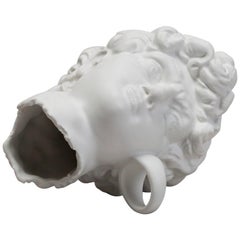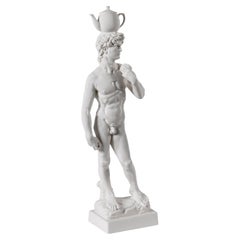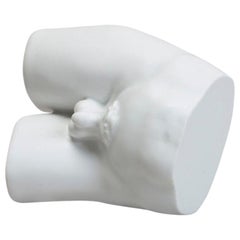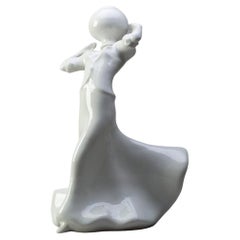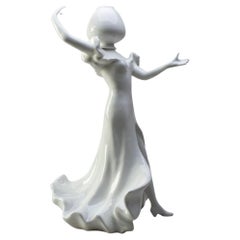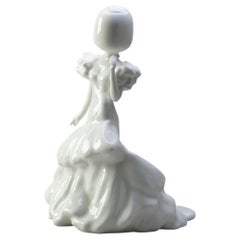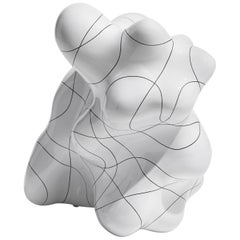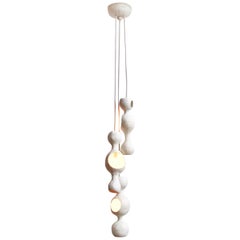MADEINBRITALY Figurative Sculptures
to
13
13
3
1
1
13
8
1
13
13
13
Height
to
Width
to
13
13
13
11
Michelangelo prèt-a-porter by Andrea Salvatori, Ceramic Sculpture Contemporary
By Andrea Salvatori
Located in London, GB
"Michelangelo prèt-a-porter " -Testone - Unique piece, 2017 glazed earthenware
A Ring Thing collection
A small chair, a miniature moon, a Philipp Stark's squeezer or the anatomic...
Category
21st Century and Contemporary Italian Renaissance Abstract Sculptures
Materials
Ceramic, Earthenware
Michelangelo David Ceramic Sculpture by Andrea Salvatori, Italy, Contemporary
By Andrea Salvatori
Located in London, GB
Andrea Salvatori, "Davidiera", 2015 glazed earthenware, measures: H 68 x 25 x 18 cm
Michelangelo's David becomes a teapot in this witty reinterpret...
Category
21st Century and Contemporary Italian Renaissance Figurative Sculptures
Materials
Ceramic
Michelangelo Prèt-a-porter Ceramic Sculptural Ring Contemporary
By Andrea Salvatori
Located in London, GB
"Michelangelo prèt-a-porter " -peneculo - Unique piece, 2017 glazed earthenware
A RING THING collection
A small chair, a miniature moon, a Philipp Stark's squeezer or the anatomi...
Category
21st Century and Contemporary Italian Renaissance Abstract Sculptures
Materials
Ceramic, Earthenware
White Ceramic Sculpture by Andrea Salvatori Italy Contemporary, 21st Century
By Andrea Salvatori
Located in London, GB
Andrea Salvatori, "Maria Teresa", 2021, glazed earthenware, measures: H 57 x 35 x 31 cm
Andrea Salvatori (Italy, 1975) is an internationally renown...
Category
21st Century and Contemporary Italian Art Deco Figurative Sculptures
Materials
Ceramic
Large White Ceramic Sculpture by Andrea Salvatori, Italy, Contemporary
By Andrea Salvatori
Located in London, GB
Andrea Salvatori, "Maria Luigia", 2021, glazed earthenware, measures: H 55 x 33 x 38 cm
Andrea Salvatori (Italy, 1975) is an internationally renown...
Category
21st Century and Contemporary Italian Art Deco Figurative Sculptures
Materials
Ceramic
Large White Ceramic Sculpture by Andrea Salvatori, Italy, Contemporary
By Andrea Salvatori
Located in London, GB
Andrea Salvatori, "Maria Clementina", 2021, glazed earthenware, measures: H 59 x 30 x 40 cm
Andrea Salvatori (Italy, 1975) is an internationally re...
Category
21st Century and Contemporary Italian Art Deco Figurative Sculptures
Materials
Ceramic
Ceramic Sculptural Ring by Andrea Salvatori Contemporary 21st Century, Art Jewel
By Andrea Salvatori
Located in London, GB
"Ring Grace", unique piece, 2017 glazed earthenware
A Ring Thing collection
A small chair, a miniature moon, a Philipp Stark's squeezer or the anatomical details of Michelangelo’...
Category
21st Century and Contemporary Italian Classical Greek Abstract Sculptures
Materials
Ceramic, Earthenware
Ceramic Sculptural Ring by Andrea Salvatori Contemporary 21st Century Art Jewel
By Andrea Salvatori
Located in London, GB
"The ring is on the table", unique piece, 2017 glazed earthenware
A Ring Thing collection
A small chair, a miniature moon, a Philipp Stark's squeezer or the anatomical details of...
Category
21st Century and Contemporary Italian Victorian Abstract Sculptures
Materials
Ceramic, Earthenware
Michelangelo Prèt-a-Porter Ceramic Sculptural Ring Contemporary
By Andrea Salvatori
Located in London, GB
"Michelangelo prèt-a-porter " - Unique piece, 2017 glazed earthenware
A RING THING collection
A small chair, a miniature moon, a Philipp Stark's squeezer or the anatomical detail...
Category
21st Century and Contemporary Italian Renaissance Abstract Sculptures
Materials
Ceramic, Earthenware
Michelangelo prèt-a-porter Andrea Salvatori Ceramic Sculptural Ring contemporary
Located in London, GB
"Michelangelo prèt-a-porter " - Unique piece, 2017 glazed earthenware
A Ring Thing collection
A small chair, a miniature moon, a Philipp Stark's squeezer or the anatomical detail...
Category
21st Century and Contemporary Italian Renaissance Abstract Sculptures
Materials
Ceramic, Earthenware
White ceramic figurine sculpture by Andrea Salvatori Italy Contemporary Unique
By Andrea Salvatori
Located in London, GB
"Invasata" - unique piece, 2020, glazed earthenware.
Andrea Salvatori (Italy, 1975) is a visual artist working in ceramics to realize ironic and witty sculptures, sometimes involv...
Category
21st Century and Contemporary Italian Baroque Abstract Sculptures
Materials
Ceramic, Earthenware
Matt White Glaze Majolica Sculpture with Hand Sculpted Peony, Italy 21st Century
Located in London, GB
Small ceramic sculptures with peony by Antonietta Mazzotti Emaldi, 2018, Glazed earthenware (majolica) and 24ct gold, entirely handmade, unique piece. Customisation available in terms of colour of both for base and flower.
Antonietta Mazzotti (Faenza, Italy 1950) attended the Istituto d’Arte per la Ceramica in Faenza and opened her first workshop in her hometown taking part in group and solo exhibitions at international level. In 1976 she has transformed the neo-gothic greenhouse of Villa Emaldi in her workshop. Antonietta Mazzotti has worked for some of the most important international museums and has received several important recognitions worldwide. Her works have been featured in major Italian magazines of interior design and she has acquired international visibility being featured in major international press publications, such as The New York Times. She still lives and works at Villa Emaldi in Faenza where she continues her research on historical decor...
Category
21st Century and Contemporary Italian Figurative Sculptures
Materials
Ceramic, Earthenware, Majolica
"Invasata" White Ceramic Sculpture by Andrea Salvatori, Italy, Contemporary
By Andrea Salvatori
Located in London, GB
"Invasata" - unique piece, 2020, glazed earthenware.
Andrea Salvatori (Italy, 1975) is a visual artist working in ceramics to realize ironic and wi...
Category
21st Century and Contemporary Italian Baroque Revival Abstract Sculptures
Materials
Ceramic
Related Items
White Contemporary Ceramic Sculpture by Steen Ipsen
By Steen Ipsen
Located in New York, NY
Organic 9, 2013 (Ceramic; Unique, C. 11 in. h x 10.5 in. w x 8 in. d, Object No.: 3645)
Steen Ipsen was born in 1966 in Denmark and lives and works in Copenhagen. He graduated in 19...
Category
2010s Danish Ceramics
Materials
Ceramic, Pottery
Contemporary Sculptural Hand-Built Multi-Shell Matte White Ceramic Pendant Lamp
By Yuko Nishikawa
Located in Brooklyn, NY
White bowerbird family is a contemporary sculptural multi-shell hand-built ceramic pendant lamp finished in a matte white glaze with a warm glow reflecting off of a round joyful form. Each shell is individually hand formed and unique, creating a pleasant rhythm when installed in multiples. The hand-built ceramic canopy, finials and socket cover add an enjoyable character.
Component dimensions and weight:
Shell: 4-6 diameter x 12-14 h in. / 10-13 diameter x 30-36 height cm
2 lbs / 1 kg each
Custom drop length, please specify
5 in. / 12.5 cm diameter ceramic canopy
Materials:
Shells, canopies, socket covers and finials in hand-built ceramic in a warm-white matte glaze, off-white nylon-covered SVT lamp wire, brushed brass hardware, and electrical components
Light source
1 x E-12 candelabra base per shell
25W incandescent lamp included
Compatible with LED replacement lamps
Additional info:
Each lamp is individually hand-built without using a mould to create an enjoyable uniqueness and spatial balance within each form. Variations in dimensions, forms, and finishes are expected.
The story:
White Bowerbird collection is from Courtship Behavior...
Category
2010s American Modern Chandeliers and Pendants
Materials
Ceramic
$3,500 / item
H 28 in W 12 in D 12 in
Nico Lamp, Sculptural Contemporary Hand-Built Ceramic Table Lamp in Matte White
By Yuko Nishikawa
Located in Brooklyn, NY
Nico is a hand-built sculptural ceramic table lamp that inspires the joy of working with hands through unpacking, assembling and balancing weights. The handmade ceramic globes and th...
Category
2010s American Modern Table Lamps
Materials
Metal
$2,400 / item
H 16 in W 9 in D 4 in
Sculpture Representing a Statue of Hercules, 21st Century.
Located in Saint-Ouen, FR
Sculpture representing a statue of Hercules, 21st Century.
Sculpture of Hercules in patinated resin, stone base, 21st century.
H: 32cm, D: 13cm
Category
21st Century and Contemporary French Modern Figurative Sculptures
Materials
Stone
Vintage Classical Plaster Wall Sculpture, Head of Michelangelo's David C1930
Located in Big Flats, NY
Vintage Classical Plaster Wall Sculpture, Head of Michelangelo's David, C1930
Measures- 18"H x 11"W x 7.25"D
Category
Early 20th Century Figurative Sculptures
Materials
Plaster
$440 Sale Price
20% Off
H 18 in W 11 in D 7.25 in
Sculptural Ceramic Vase
Located in Antwerp, BE
A monumental shaped ceramic vase in various beautiful colors and patterns.
Measures: Height 43 cm.
Category
Mid-20th Century Italian Hollywood Regency Vases
Materials
Ceramic
Contemporary Sculptural Hand-Built Double-Shell Matte White Ceramic Pendant Lamp
By Yuko Nishikawa
Located in Brooklyn, NY
White Bowerbird couple is a contemporary double-shell hand-built ceramic pendant lamp finished in a matte white glaze with a warm glow reflecting off of a round joyful form. Each shell is individually hand formed and unique, creating a pleasant rhythm when installed as a pair. The hand-built ceramic canopy, finials and socket cover add an enjoyable character.
Component dimensions:
Shell 4-6 diameter x 12-14 height in. / 10-13 diameter x 30-36 height cm; 2 lbs / 1 kg each
Custom drop length, please specify
5 in. / 12.5 cm diameter ceramic canopy
Materials:
Shells, canopies, socket covers and finials in hand-built ceramic in a warm-white matte glaze, off-white nylon-covered SVT lamp wire, brushed brass hardware, and electrical components
Light source:
1 x E-12 candelabra base per shell
25W incandescent lamp included
Compatible with LED replacement lamps
Additional info:
Each lamp is individually hand-built without using a mould to create an enjoyable uniqueness and spatial balance within each form. Variations in dimensions, forms, and finishes are expected.
The story:
White Bowerbird collection is from Courtship behaviour, a project inspired by the curious behaviour of the Satin Bowerbird, the eastern Australian birds...
Category
2010s American Modern Chandeliers and Pendants
Materials
Ceramic
$2,500 / item
H 13 in W 12 in D 5 in
Wave - Contemporary White Ceramic Sculpture by Rachel Peters, UK, In Stock.
By Rachel Peters Ceramics
Located in Wirral, GB
Wave - Contemporary White Ceramic Sculpture by Rachel Peters, UK, In Stock.
Wave is a hand-built ceramic sculpture made from grogged white stoneware, with a soft slip finish that’s ...
Category
2010s British Modern Abstract Sculptures
Materials
Ceramic
$1,900
H 9.85 in W 21.26 in D 3.55 in
Contemporary Sculptural Hand-built Single-Shell Matte White Ceramic Pendant Lamp
By Yuko Nishikawa
Located in Brooklyn, NY
White Bowerbird single is a contemporary single-shell hand-built ceramic pendant lamp finished in a matte white glaze with a warm glow reflecting off of a round joyful form. The humorous friendly form makes a playful interior accent when installed with a single shell. The individually hand-built ceramic canopy, finials and socket cover add an enjoyable uniqueness.
Component dimensions
Shell: 4-6 diameter x 12-14 height in. / 10-13 diameter x 30-36 height cm
2 lbs / 1 kg each
Custom drop length, please specify
5 in. / 12.5 cm diameter ceramic canopy
Materials:
Shells, canopies, socket covers and finials in hand-built ceramic in a warm-white matte glaze, off-white nylon-covered SVT lamp wire, brushed brass hardware, and electrical components
Light source:
1 x E-12 candelabra base per shell
Compatible with LED replacement lamps
Additional info:
Each lamp is individually hand-built without using a mould to create an enjoyable uniqueness and spatial balance within each form. Variations in dimensions, forms, and finishes are expected.
The story:
White Bowerbird Collection is from Courtship Behavior...
Category
2010s American Modern Chandeliers and Pendants
Materials
Ceramic
$1,550 / item
H 13 in W 5 in D 5 in
Sculpture of Diana the Huntress, 21st Century.
Located in Saint-Ouen, FR
Sculpture of Diana the Huntress, 21st century.
Sculpture on base of Diana the Huntress, in patinated plaster and resin, 21st century, model from the Musée du Louvres, Paris.
H: 32c...
Category
21st Century and Contemporary French Modern Busts
Materials
Resin, Plaster
$1,511 Sale Price / item
20% Off
H 12.6 in W 9.06 in D 7.49 in
Bronze Sculpture Of David By Michelangelo
Located in Madrid, ES
Bronze Sculpture Of David By Michelangelo
Large patinated bronze sculpture of David by Michelangelo. Excellent condition. 1950s. Dimensions: 84x2...
Category
Mid-20th Century Figurative Sculptures
Materials
Bronze
Rare and important painted bronze Crucifix after a model by Michelangelo
By Michelangelo Buonarroti
Located in Leesburg, VA
A rare and very fine bronze corpus of Christ after a model by Michelangelo, cast ca. 1597-1600 by Juan Bautista Franconio and painted in 1600 by Francisco Pacheco in Seville, Spain.
The present corpus reproduces a model attributed to Michelangelo. The best known example, lesser in quality, is one on display at the Metropolitan Museum of Art (MET).
The association of this corpus with Michelangelo was first brought to light by Manuel Gomez-Moreno (1930-33) who studied the wider circulated casts identified throughout Spain. The attribution to Michelangelo was subsequently followed by John Goldsmith-Phillips (1937) of the MET and again by Michelangelo expert, Charles de Tolnay (1960).
While Michelangelo is best known for his monumental works, there are four documented crucifixes he made. The best known example is the large-scale wooden crucifix for the Church of Santa Maria del Santo Spirito in Florence, made in 1492 as a gift for the Prior, Giovanni di Lap Bicchiellini, for allowing him to study the anatomy of corpses at the hospital there. In 1562, Michelangelo wrote two letters to his nephew, Lionardo, indicating his intention to carve a wooden crucifix for him. In 1563 a letter between Lionardo and the Italian sculptor Tiberio Calcagni, mentions this same crucifix (a sketch of a corpus on the verso of a sheet depicting Michelangelo’s designs for St. Peter’s Basillica [Palais des Beaux-Arts in Lille] may reproduce this). That Michelangelo was working on small corpora in the last years of his life is further evidenced by the small (26.5 cm) unfinished wooden crucifix located at the Casa Buonarroti, considered his last known sculptural undertaking. Michelangelo’s contemporary biographer, Giorgio Vasari additionally cites that Michelangelo, in his later years, made a small crucifix for his friend, Menighella, as a gift.
Surviving sketches also indicate Michelangelo’s study of this subject throughout his career, most notably during the end of his life but also during the 1530s-40s as he deepened his spiritual roots. The occasional cameo of crucified Christ’s throughout his sketched oeuvre have made it challenging for scholars to link such sketches to any documented commissions of importance. All the while, in consideration that such objects were made as gifts, it is unlikely they should be linked with commissions.
Nonetheless, a number of theories concerning Michelangelo’s sketches of Christ crucified have been proposed and some may regard the origin of the present sculpture. It has been suggested that the corpus could have its impetus with Michelangelo’s work on the Medici Chapel, whose exclusive design was given to the master. It is sensible smaller details, like an altar cross, could have fallen under his responsibility (see for example British Museum, Inv. 1859,0625.552). Others have noted the possibility of an unrealized large marble Crucifixion group which never came to fruition but whose marble blocks had been measured according to a sheet at the Casa Buonarroti.
A unique suggestion is that Michelangelo could have made the crucifix for Vittoria Colonna, of whom he was exceedingly fond and with whom he exchanged gifts along with mutual spiritual proclivities. In particular, Vittoria had an interest in the life of St. Bridget, whose vision of Christ closely resembles our sculpture, most notably with Christ’s proper-left leg and foot crossed over his right, an iconography that is incredibly scarce for crucifixes. The suggestion could add sense to Benedetto Varchi’s comment that Michelangelo made a sculpted “nude Christ…he gave to the most divine Marchesa of Pescara (Vittoria Colonna).”
Of that same period, two sketches can be visually linked to our sculpture. Tolnay relates it to a sketch of a Crucified Christ at the Teylers Museum (Inv. A034) of which Paul Joannides comments on its quality as suggestive of preparations for a sculptural work. Joannides also calls attention to a related drawing attributed to Raffaello da Montelupo copying what is believed to be a lost sketch by Michelangelo. Its relationship with our sculpture is apparent. Montelupo, a pupil of Michelangelo’s, returned to Rome to serve him in 1541, assisting with the continued work on the tomb of Pope Julius II, suggesting again an origin for the corpus ca. 1540.
The earliest firm date that can be given to the present corpus is 1574 where it appears as a rather crudely conceived Crucifixion panel, flanked by two mourners in low-relief and integrally cast for use as the bronze tabernacle door to a ciborium now located at the Church of San Lorenzo in Padula. Etched in wax residue on the back of the door is the date, 27 January 1574, indicating the corpus would have at least been available as a model by late 1573.
The Padula tabernacle was completed by Michelangelo’s assistant, Jacopo del Duca and likely has its origins with Michelangelo’s uncompleted tabernacle for the Basilica of St. Mary of the Angels in Rome.
The impetus for the Padula tabernacle’s Crucifixion panel begins with a series of late Crucifixion sketches by Michelangelo, depicting a scene of Christ crucified and flanked by two mourners (see British Museum Inv. 1895.0915.510; Ashmolean Museum Inv. 1846.89, KP II 343 recto; Windsor Castle RCIN 912761 recto; and Louvre Inv. 700). A faintly traced block possibly intended for sculpting the sketch of the crucified Christ on its recto was discovered by Tolnay on a version of the composition at Windsor Castle. The Windsor sketch and those related to it appear to have served as preparatory designs for what was probably intended to become the Basilica of St. Mary’s tabernacle door. Vasari documents that the project was to be designed by Michelangelo and cast by his assistant, Jacopo del Duca. Michelangelo died before the commission was complete, though on 15 March 1565, Jacopo writes to Michelangelo’s nephew stating, “I have started making the bronze tabernacle, depending on the model of his that was in Rome, already almost half complete.” Various circumstances interrupted the completion of the tabernacle, though its concept is later revitalized by Jacopo during preparations to sell a tabernacle, after Michelangelo’s designs, to Spain for Madrid’s El Escorial almost a decade later. The El Escorial tabernacle likewise encountered problems and was aborted but Jacopo successfully sold it shortly thereafter to the Carthusians of Padula.
An etched date, 30 May 1572, along the base of the Padula tabernacle indicates its framework was already cast by then. A 1573 summary of the tabernacle also describes the original format for the door and relief panels, intended to be square in dimension. However, a last minute decision to heighten them was abruptly made during Jacopo’s negotiations to sell the tabernacle to King Phillip II of Spain. Shortly thereafter the commission was aborted. Philippe Malgouyres notes that the Padula tabernacle’s final state is a mixed product of the original design intended for Spain’s El Escorial, recycling various parts that had already been cast and adding new quickly finished elements for its sale to Padula, explaining its unusually discordant quality, particularly as concerns the crudeness of the door and relief panels which were clearly made later (by January 1574).
Apart from his own admission in letters to Spain, it is apparent, however, that Jacopo relied upon his deceased master’s designs while hastily realizing the Padula panels. If Michelangelo had already earlier conceived a crucifix model, and Jacopo had access to that model, its logical he could have hastily employed it for incorporation on the door panel to the tabernacle. It is worth noting some modifications he made to the model, extending Christ’s arms further up in order to fit them into the scale of the panel and further lowering his chin to his chest in order to instill physiognomic congruence. A crude panel of the Deposition also follows after Michelangelo’s late sketches and is likewise known by examples thought to be modifications by Jacopo based upon Michelangelo’s initial sculptural conception (see Malgouyres: La Deposition du Christ de Jacopo del Duca, chef-d’oeuvre posthume de Michel-Ange).
Jacopo’s appropriation of an original model by Michelangelo for more than one relief on the Padula tabernacle adds further indication that the crucifix was not an object unique to Jacopo’s hand, as few scholars have posited, but rather belongs to Michelangelo’s original...
Category
Antique 16th Century Renaissance Figurative Sculptures
Materials
Bronze
$199,000
H 26.25 in W 11.25 in D 4 in
